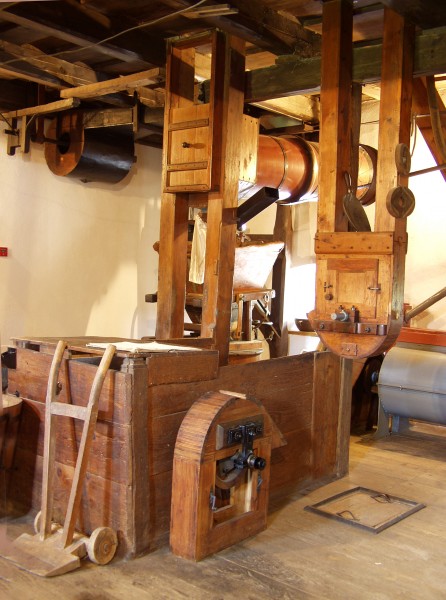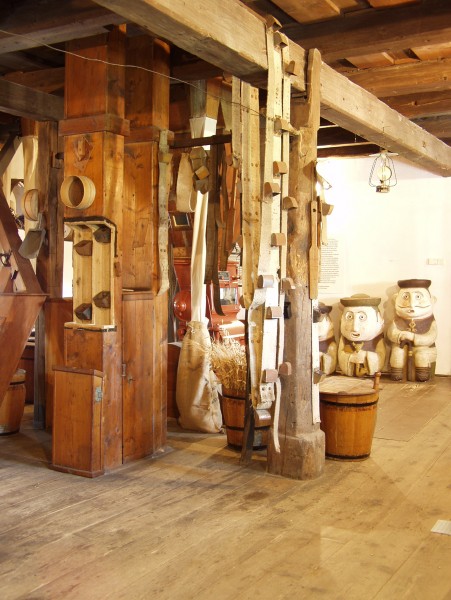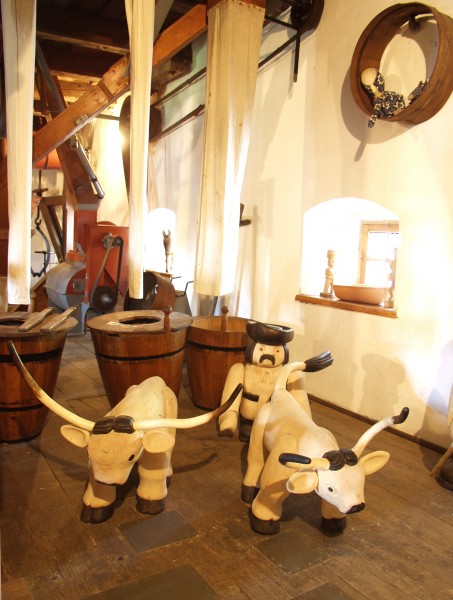Photo |1-5|: Photo-Department of the Slovak National Gallery View of the Mill interior
Selection from the Naïve Art Collection
Curator: Katarína Čierna
The naïve art collection, a special collection of the Slovak National Gallery, was established in 1965. The new exposition includes a representative selection of paintings, sculptures and drawings of particularly Slovak, but also foreign authors. The intention is to introduce the new authors, but equally to call attention to well-known artists through works which have yet to be exhibited on the premises of the Gallery of Naïve Art.
Ondrej Šteberl (1897 Pezinok – 1977 Bratislava) a mailman, was an artist with extraordinary invention. He depicted the world of fairy tales and legends through poetic metaphors, pantomimes of forms and shapes, allegorical figures and characters from the Old and New Testaments. His painting expression has its own ornamental-symbolic rules and is characterized by form deformation, flat inkling of painting, a gracious line and the use of non-fractioned tones of glowing colors. He is one of the most significant artists not only in Slovakia, but also Europe. Juraj Lauko (1894 Sarvaš, Hungary – 1974 Bratislava) a certified butcher, created a pictorial chronicle of the life of a Slovak in the Lower Lands (Hungary). His lyrical delivery with its fiery color is one of his trademarks. The paintings of Zuzana Virághová (1885 – 1979 Košice) a housewife, are full of balladic poetry and the magic of silent recollections of southern Slovakia. Her shaping approaches are essentially pure, she uses only a palette of soft green tones. Anna Ličková (1895 Těšín, Czech Republic – 1975 Čadca) a child caretaker and laborer, has not been overlooked among the female Slovak artists. Her work is connected with the memories of the past, emotionally confidential outdoor locations which she developed into compositions full of metaphors. The paintings are shining fairy tales and will attract our attention by their strong fine art instinct for shape and form. The world of paintings of Júlia Bartuszová (1904 Okoč – 1990 Štúrovo) a housewife, is woven from memories. From comebacks. From pauses in time and space. She created interiors of old rooms and kitchens with her own geometric and hierarchic order. She used strong simplification with fine art signs with random color ratios and rhythms. The physician Július Považan (1926 Žiar nad Hronom, lives in Krupina) is one of the most specific representatives of Slovak naïve painting. He is inspired by the countryside of his childhood when depicting folk mysteries, legends and fairy tales; his work features scenes from the life of miners of Štiavnica. He developed his painting program in figural compositions. The freshness of is work is amplified by an impressive palette of luscious tones. Ján Hlavatý (1906 – 1992, Bratislava-Vajnory) a clerk and laborer, spontaneously applied a child’s perspective. He gladly returned to his memories of the fun and games of his childhood and to the calendar-related traditions in his suburban municipality. The work of Nella Kompánková (1933 Bielovce, residing in Bratislava) an actress and ballet dancer, is characterized by urban motifs with merry colors and right angle compositions. Pavol Hronec (1899 Hradište – 1984 Bratislava) a clerk, was inspired by his favorite novel by Victor Hugo “The Hunchback of Notre-Dame” and “re-told” the stories under the influence of the naïveté of his imaginations with passionate expression and a classic beauty of form. Mária Žilavá (1909 Malacky – 1980 Bratislava-Devín) a housewife, expressed herself in sculpture, mostly reliefs. Her most original and fascinating works are tall, monumental “totems” with a number of faces arranged on top of each other. She also materialized her imagination in painting. The sculptor Štefan Siváň (1906 – 1995 Babín) a laborer and wheelwright, depicted the world steeped in the old spiritual structures of an Orava village. He connected the folk woodcarving tradition with his own means of expression in a special style. The work of Natalia Schmidtová (1895 Dobrinka, Russia – 1981 Rozsochy, Czech Republic) originally a chambermaid and nanny, is characterized by bizarre fantasy. Through intuitive graphism and primary schematism she created compositions expressing memories of her youth by the Black Sea. She also liked to transport herself in fantasy to unknown lands; thus we can also find in her work paintings of exotic “trips.” The spontaneous stroke of brush was simple, her means of expression elementary. Cecilie Marková (1911 – 1998 Kyjov, Czech Republic) a certified milliner, drew flowers by automatic gesture, which were not from the real world, but grew from her fantasy. She equally painted astral lands and cosmic eruptions. The paintings of Jan Hruška (1918 Lysice – 2004 Brno, Czech Republic) a drugstore worker, will attract our attention by his specific painting technique, his own invention. He created his works by layering oil paints by syringe and needles. Flowers, bouquets, heather, tulips, forget-me-nots or flower bushes and gardens, but particularly urban squares, were his favorite themes. He concentrated and ritually created linear compositions through precise and repeated details. He spun the glowing colors that sparkle like enamel as a netting. Each line has its own matter in full shining color, by means of which plastic creation originated and which evokes a free analogy with medieval jewels and book illuminations. The technology of the glass pictures of Rudolf Dzurko (1941 Pavlovce, Slovakia, residing in Prague) is also original. He has access to it in the glass factory in Nový Bor, where he was captured by the idea of using glass waste. He invented a specific method: he crushes pieces of glass with a manual press and subsequently layers the crushed glass in various intensity on the area of “painting” and glues it with special resins. Through this technique Dzurko achieved an impressive relief surface where warm sharp-red, deep-yellow and orange alternate with cold green, turquoise and blue. Poetic position alternates with expressive utterance in his paintings. He projects in them his dreams, desires and real and mythical stories from the Roma community. Festivities and sporting events were favorite themes for Karl Willam Petit (1893 – 1980 Carnières, Belgium) a metallurgist. His work features his excellent story-telling talent and exceptional sense of color. His strong fine art instinct for shape and form will attract attention. Waldomiro de Deus (1944 Boa Nova, Brazil) a gardener and mason, is faithful to figural depiction, however distant to the reproduction of reality, his volumes are simple and reduced to essential signs. All of the author’s paintings are a colorful explosion of fresh tones. His compositions lack perspective and it seems that the motifs “float” in space.
The works of other authors represented in the exposition also come together in original imagination and invention despite their differences in expression.




